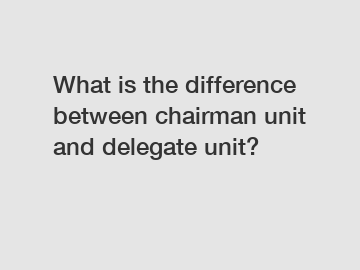Mar. 12, 2024
Office & School Supplies
You will get efficient and thoughtful service from VISSONIC.
In the world of conference technology and communication systems, two types of units that often come into play are the chairman unit and the delegate unit. While these units may seem similar at first glance, there are some key differences between them that are important to understand. In this blog post, we will explore the distinctions between chairman and delegate units, and delve into the unique capabilities and functionalities of each.
First and foremost, let's start with the basics. Chairman units are typically used by the person leading a meeting or conference, while delegate units are used by the participants. The chairman unit is designed to give the chairperson greater control over the meeting, enabling them to manage the flow of conversation and ensure that order is maintained. Delegate units, on the other hand, are used by attendees to express their opinions, ask questions, and participate in discussions.

One of the key differences between chairman and delegate units is the level of control they offer. Chairman units typically come equipped with features that allow the chairperson to mute or enable audio for individual delegate units, control speaking time limits, and even prioritize speakers. This level of control is essential for managing large meetings or conferences where multiple participants are vying for the floor.
Delegate units, on the other hand, are more straightforward in terms of functionality. They typically feature a microphone for speaking, a speaker for listening, and a voting button for participating in polls or elections. Delegate units are designed to be user-friendly and intuitive, allowing participants to easily engage with the conversation without the need for complex controls or advanced features.
Another key difference between chairman and delegate units is the level of priority they offer. Chairman units are given top priority in terms of speaking rights, meaning that the chairperson can always override delegate units and speak at any time. This ensures that the chairperson has the final say in steering the conversation and managing the meeting agenda.
Delegate units, on the other hand, are designed to give participants an equal voice in the conversation. While delegate units can request to speak and be recognized by the chairperson, they do not have the same level of control or priority as chairman units. This ensures that all participants have a fair chance to contribute to the discussion and express their opinions.
In terms of design and aesthetics, chairman and delegate units also have distinct differences. Chairman units are often sleek and modern in appearance, with a larger display screen and more advanced controls. Delegate units, on the other hand, are typically more compact and simple in design, with basic features that are easy to navigate for all users.
In conclusion, while chairman and delegate units may seem similar on the surface, there are several key differences that set them apart. Chairman units are designed for the person leading the meeting, offering greater control and priority in steering the conversation. Delegate units, on the other hand, are meant for participants to engage in the discussion and express their opinions. Understanding these differences is essential for ensuring a smooth and successful conference or meeting experience.
For more information, please visit our website.
For more information, please visit 4k video wall controller.
If you are interested in sending in a Guest Blogger Submission,welcome to write for us!
All Comments ( 0 )